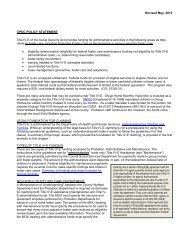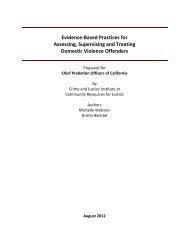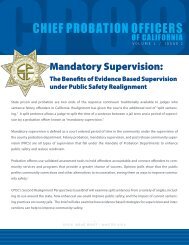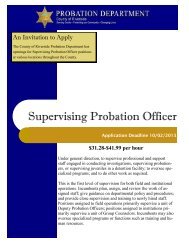Lassen County - Chief Probation Officers of California
Lassen County - Chief Probation Officers of California
Lassen County - Chief Probation Officers of California
You also want an ePaper? Increase the reach of your titles
YUMPU automatically turns print PDFs into web optimized ePapers that Google loves.
Page 10Additional inmates in the jail will also impact: Energy consumption, Food service, laundryexchange, inmate programs like exercise yard, dayroom, commissary, along with medical,dental, and prescription drug costs. It can be difficult to quantify all <strong>of</strong> the costs associatedwith the expansion <strong>of</strong> these programs, but every increase in average daily population willgenerate additional costs. Inmate medical issues in a custody setting are impossible topredict. Increased inmate population does not automatically correlate to additionalmedical costs. However, any one inmate could generate significant increased costs basedon an acute medical condition, emergency surgery, or an expensive prescription regiment.This new population may potentially have significant impact on our inmate transportation.Any / all new inmates entering our local jail system will require transportation to or fromcourts and medical appointments. There will also be increases in the transportationdemand specific to parole and PRCS violators. Historically, if a parole violator was takeninto custody in any local jurisdiction, they were booked in the local facility, transferred toprison where the prison transportation system moved them throughout the state. Movingforward, these violators will stay in county jails for their entire period <strong>of</strong> incarceration.Since CDCR will no longer be involved in the housing and transportation <strong>of</strong> these inmates,this burden will shift entirely to local jails. <strong>Lassen</strong> <strong>County</strong> will help move inmates to / fromour county as part <strong>of</strong> the new parole violator shift to local custody. Additionally, therecould be increased incarceration costs and a drop in revenues for parole violators.Historically, counties were able to bill the state for daily incarceration costs for state paroleviolators. Moving forward, the state has no responsibility or jurisdiction over localviolators. There is potential for one county to directly bill another county for daily housingcosts <strong>of</strong> parole violators. This issue is still unsettled amongst <strong>California</strong> Sheriffs, but basedon housing and budgetary constraints in each county; billing between counties for bedspace and / or transportation could take place in the future. Considering these additionalcosts, <strong>Lassen</strong> <strong>County</strong> has to be prepared to move as soon as allowable under state law toreclaim our parole violators in other counties. We also have to be prepared to release /transport back parole violators from other jurisdictions as soon as possible to avert anyadditional housing, medical, or prescription drug costs.The increased inmate population coupled with the new programs developed for our entirejail population will change all aspects <strong>of</strong> our custody operations. Every new booking andnewly sentenced inmate will require a comprehensive classification to determine his / hereligibility for any alternative to custody program. Sheriff’s personnel are already draftingor enhancing these alternative programs. The Sheriff already has established the followingprograms: Sheriff’s Work Alternative Program (SWAP), Work Furlough, and Sheriff’sParole. In addition to those programs, Sheriff’s Personnel are also developing protocols forhome detention, GPS electronic monitoring, weekend commitments, and day reporting.Once all <strong>of</strong> these programs are in place, the classification process will be an essentialcomponent <strong>of</strong> determining which <strong>of</strong>fenders are eligible to participate. These programs willhave to be accessible to every person incarcerated in the county jail. AB109 inmates are anew class <strong>of</strong> “local felons.” As such, we cannot exclusively consider these AB109 inmatesfor alternatives to physical custody, unless we also consider all traditional misdemeanor<strong>of</strong>fenders as well. It would be illogical to release felony <strong>of</strong>fenders into our community









